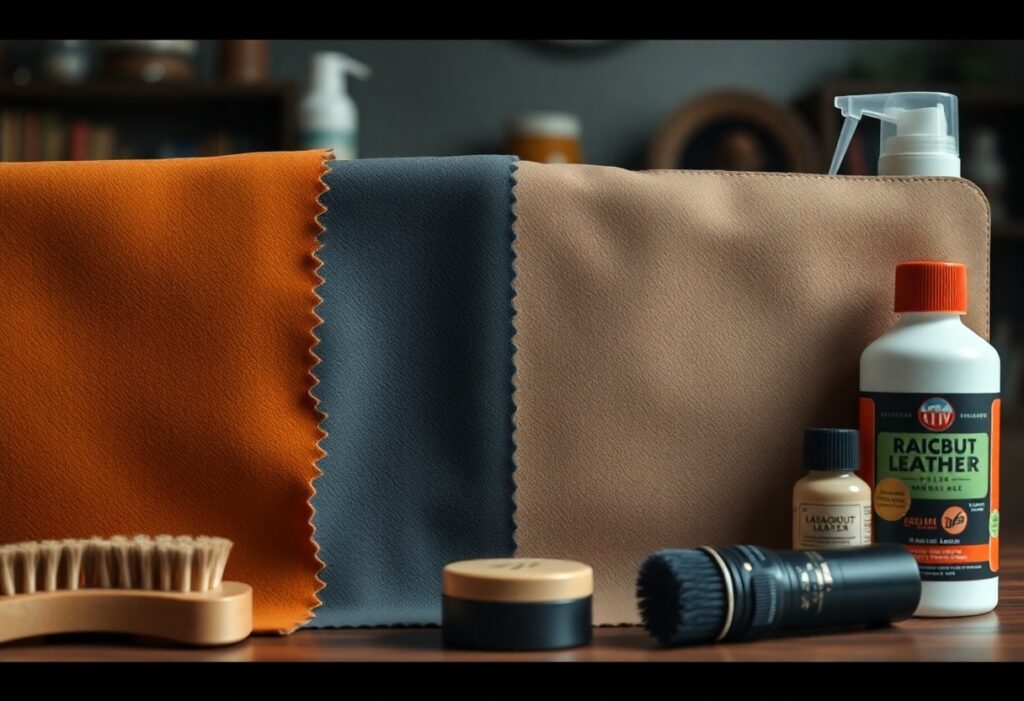
Nubuck, suede, and roughout leather each offer unique characteristics that affect your leather goods’ durability and appearance. You’ll find these materials in everything from shoes to jackets, with each type requiring specific care methods. Nubuck offers the highest durability due to its dense grain structure, while suede provides a softer, more luxurious feel. Your roughout leather items need extra protection against water damage. By understanding these differences, you can choose the right leather type for your needs and maintain your items properly. This guide will help you identify each leather type and show you the best ways to care for your leather goods.

Understanding Different Types of Napped Leather
For leather enthusiasts and buyers, understanding napped leather varieties is vital to make informed purchasing decisions. These include nubuck, split suede, full reverse suede, and roughout leather. Though they may look similar, each type has unique characteristics and uses. Understanding these differences helps you choose the right leather for your needs.
| Type | Key Features |
|---|---|
| Nubuck | Sanded grain surface, durable |
| Split Suede | Made from corium layer, less durable |
| Full Reverse Suede | Full grain leather reversed, strong core |
| Roughout | Untreated corium surface, rugged texture |
| Care Requirements | Waterproofing needed for all types |
Nubuck Leather Characteristics
While nubuck shares visual similarities with suede, it offers superior durability due to its grain leather construction. The surface is lightly sanded to create a fine, velvety nap, making it more resistant to wear than other napped leathers.
Split Suede Properties
Understanding split suede begins with its construction from the corium layer of the hide. This leather type features loose fibers and a soft texture but requires careful maintenance due to its porous nature.
Types of split suede vary based on the animal hide used and processing methods. You’ll find options ranging from lightweight fashion suede to heavy-duty footwear suede, each with specific applications.
Full Reverse Suede Features
Understanding full reverse suede reveals its unique construction – a full-grain leather turned inside out. This creates a suede-like surface while maintaining the structural integrity of full-grain leather.
With its grain layer intact, full reverse suede provides better water resistance and durability compared to split suede. You’ll find this leather type commonly used in high-end footwear and leather goods requiring both aesthetics and durability.
Roughout Leather Attributes
Characteristics of roughout leather include an intentionally unrefined surface and exceptional durability. You’ll notice its distinctively rugged texture, setting it apart from other napped leathers.
The roughout leather’s construction maintains the full hide structure, making it particularly suitable for work boots and outdoor gear. You’ll appreciate its natural aging process and ability to develop a unique patina over time.

Key Differences Between Leather Types
There’s a clear distinction between nubuck, suede, and roughout leather in terms of their construction and characteristics. Each type offers unique properties for different applications and wear conditions. After understanding these differences, you can make better choices for your leather goods.
| Feature | Characteristics |
|---|---|
| Origin | Grain layer vs Corium layer |
| Surface | Fine vs Coarse nap |
| Durability | High to moderate resistance |
| Maintenance | Regular to intensive care |
| Applications | Footwear to accessories |
Material Structure Comparison
Now let’s examine how these leathers differ in their fundamental structure:
| Leather Type | Structure |
|---|---|
| Nubuck | Sanded grain layer |
| Suede | Split corium layer |
| Roughout | Reversed full grain |
Surface Texture Analysis
To understand the surface characteristics better, examine the nap length and texture of each type. Nubuck features the shortest, finest nap, while roughout shows a more irregular, coarse texture.
Material differences in texture affect how each leather type responds to wear and treatment. Suede develops a distinct patina, while nubuck maintains a more uniform appearance over time.
Durability Factors
If you’re considering longevity, note these key factors:
- Water resistance varies significantly
- Wear patterns develop differently
- Structural integrity depends on leather type
Any damage to the surface requires specific repair methods.
Another important aspect of durability involves environmental factors:
- UV exposure affects color retention
- Temperature changes impact leather flexibility
- Moisture levels influence material stability
Any protective treatment should match your leather type.
Care and Maintenance Guidelines
Unlike smooth leather, napped leathers require specific care techniques to maintain their texture and appearance. Your nubuck, suede, and roughout leather items need regular brushing, protection from water damage, and careful cleaning to preserve their unique characteristics. These materials are more susceptible to staining and water damage than smooth leather, making proper maintenance important.
Cleaning Methods
To clean your napped leather items, use a specialized suede brush in one direction to remove surface dirt. You can use a suede eraser for stubborn stains, and avoid water-based cleaning methods whenever possible. For deeper cleaning, use only products specifically designed for your leather type, as regular leather cleaners can damage the nap.
Protection Techniques
The most effective way to protect your napped leather is to apply a high-quality water repellent spray. You should treat new items before their first use and reapply protection every 3-4 months. This creates a protective barrier while maintaining the leather’s breathability.
Understanding proper protection methods helps extend your leather items’ life. Regular maintenance includes checking for wear spots, reapplying protector after heavy use, and avoiding direct heat or sunlight exposure. Your protection routine should match your usage frequency – more frequent for daily-wear items.
Storage Recommendations
Storage of napped leather requires careful attention to environment. You should keep items in a cool, dry place away from direct sunlight. Use shoe trees for footwear and stuff bags with paper to maintain their shape. Never store in plastic bags, as leather needs to breathe.
Recommendations for long-term storage include using breathable cloth bags, maintaining good air circulation, and regular checks for moisture or mold. Your storage area should have 40-50% humidity to prevent leather from drying out or developing mildew. Keep items separated to prevent color transfer and maintain their individual shapes.

Practical Applications and Uses
Your choice of nubuck, suede, or roughout leather affects the final product’s durability and appearance. Each type serves specific purposes based on their unique properties. Nubuck offers superior durability for high-wear items, while suede provides a softer, more flexible option for fashion pieces.
Footwear Applications
Even though all these leathers work well in footwear, each type has its strengths. Nubuck excels in outdoor and work boots due to its durability, while split suede is perfect for dress shoes and casual sneakers. Roughout leather creates excellent hiking boots that resist scuffs and scratches.
Garment Manufacturing
Uses of these leathers in clothing vary widely. Suede works best for fashion jackets, while roughout leather creates durable work wear. Nubuck appears less frequently in garments but makes excellent protective panels on motorcycle gear.
For instance, you’ll find split suede in lightweight jackets and vests, while roughout leather appears in heavy-duty work shirts and pants. The material choice depends on the garment’s intended use – fashion items typically use softer suedes, while protective gear uses tougher nubuck or roughout.
Accessories and Other Uses
You can find these leathers in various accessories. Nubuck makes excellent watch straps and belts, while suede creates attractive bags and wallets. Roughout leather works well for durable outdoor gear like backpacks.
With proper material selection, you can create accessories that match their intended use. Split suede works best for decorative items, while nubuck and roughout excel in items needing high wear resistance. Consider water exposure when selecting leather type for outdoor accessories.
Factors Affecting Quality
Keep in mind that the quality of napped leather depends on several key elements including hide selection, tanning process, and manufacturing methods. The final product’s durability and appearance rely on these necessary factors.
Hide Selection
You need to understand that premium hides come from animals raised in optimal conditions. These hides show fewer surface defects and have more uniform fiber structure. Your leather’s quality starts with selecting hides that have minimal scarring and proper thickness.
Tanning Process
Hide processing through vegetable or chrome tanning significantly impacts the final leather quality. Each method creates distinct characteristics in terms of water resistance, flexibility, and color absorption.
This stage requires precise control of temperature, pH levels, and chemical concentrations. Your leather’s durability and texture depend on these carefully managed conditions during the 4-6 week tanning period.
Manufacturing Methods
For napped leather production, specialized buffing techniques create the characteristic surface texture. Your leather’s final appearance depends on the depth of buffing and fiber exposure.
A consistent manufacturing process ensures uniform nap height and direction. Your leather’s wear resistance and aesthetic appeal directly relate to the precision of these manufacturing steps.
Pros and Cons Analysis
All napped leathers offer unique characteristics that make them suitable for different applications. Your choice between nubuck, suede, and roughout should depend on your specific needs and intended use.
| Pros | Cons |
|---|---|
| Unique aesthetic appeal | Requires regular maintenance |
| Soft, comfortable texture | More susceptible to water damage |
| Good breathability | Shows wear marks easily |
| Various color options | Needs special cleaning products |
| Versatile applications | Higher maintenance costs |
Advantages of Each Type
There’s specific benefits to each type of napped leather. Nubuck offers superior durability due to its dense grain structure, while suede provides excellent flexibility and softness. Roughout leather gives you the best of both worlds with its unique texture and strength.
Limitations and Considerations
Even with proper care, each type has its limitations. Water exposure can seriously damage untreated napped leathers, and regular maintenance is crucial to maintain their appearance.
Analysis shows that your choice should align with your usage patterns. Indoor applications face fewer risks than outdoor use, and factors like climate and frequency of wear will impact the leather’s longevity and performance.
Conclusively, your understanding of nubuck, suede, and roughout leather will help you make informed choices for your leather goods. You can now identify the key differences between these leather types based on their construction, durability, and care needs. By applying the right care methods for each type – using waterproof sprays for nubuck, gentle brushing for suede, and appropriate treatments for roughout leather – you will extend the life of your leather items. This knowledge enables you to select the best leather type for your specific needs and maintain its quality over time.
FAQ
What are the main differences between nubuck and suede leather?
Nubuck uses the grain layer of leather that is lightly sanded on top, making it more durable and water-resistant. Suede comes from the softer bottom layer (corium) of the hide, which makes it more porous and less durable. Nubuck has a shorter, finer nap compared to suede’s longer, softer texture.
How should I protect and clean napped leathers?
Apply waterproof spray to all napped leathers before use. Clean with a suede brush to remove dirt and restore nap. Use specialized suede/nubuck cleaners for stains. Avoid wearing in heavy rain. Let wet leather dry naturally at room temperature. Brush after drying to restore the nap.
What is roughout leather and how does it differ from reverse suede?
Roughout leather keeps the corium layer untreated and rough, while reverse suede has this layer sanded smooth. Both types have the grain layer facing inward, making them more durable than split suede. Roughout has a more textured, uneven surface compared to reverse suede’s uniform nap. Both types work well for unlined shoes because their flesh side is smooth.

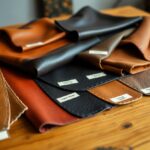
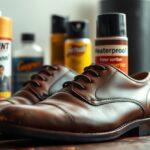
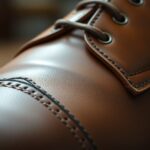
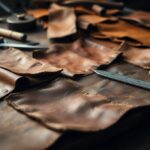

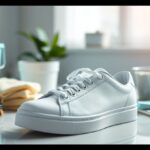

Your breakdown of nubuck, suede, and roughout leather is insightful, especially for those of us who care about the longevity and aesthetic of our leather goods. I’ve always had a soft spot for suede due to its luxurious texture, but I’ve learned the hard way about its susceptibility to stains. It makes me wonder how many people overlook the critical care differences between these types.
It’s interesting to hear about your experiences with suede. Its luxurious texture does have a special appeal, yet the care required can catch many by surprise. Many people, including myself at one point, often think of leather care as a one-size-fits-all solution, but each type really does require a tailored approach.
Your exploration of nubuck, suede, and roughout leather highlights the intricacies involved in selecting and caring for leather goods. I’ve always appreciated how the choice of leather can significantly impact both the practicality and aesthetic of items. For example, I tend to gravitate towards nubuck shoes for their durability, especially when I know I’ll be on my feet for long periods. However, I also love the softness of suede for jackets, even if that necessitates extra caution during rainier days.
It’s great to hear that you’re a fan of nubuck for shoes. The balance between comfort and ruggedness in nubuck really does make it a solid choice for all-day wear. Its texture also lends a unique richness that can elevate a casual outfit, wouldn’t you agree?
It’s fascinating how the choice of leather type can significantly influence both the durability and aesthetics of a product. I’ve always been drawn to nubuck for its resilience, especially for outdoor footwear. However, I’ve learned the hard way that its cleaning and maintenance require some diligence, particularly when exposed to moisture.
You make such a great point about nubuck. I’ve always appreciated how it strikes a balance between ruggedness and a soft, inviting appearance, making it a popular choice for outdoor footwear. Your experience with its maintenance really resonates with me. I once had a pair that I loved, but after a muddy hike, I underestimated how tricky it could be to clean. It taught me to always have a good brush and protective spray on hand.
I totally get your fascination with nubuck; it’s a great choice for durability, but I recently came across some insightful strategies for managing moisture in footwear that could really complement your knowledge on leather care.
‘Xero Shoes for Sweaty Feet: 2025 Moisture Control Strategies’
https://myshoesfinder.com/xero-shoes-2025-moisture-control-for-sweaty-feet/.
It’s great to hear your thoughts on nubuck! You hit the nail on the head about how it walks that fine line between ruggedness and a soft appearance. It really does have a character all its own, which can be hard to find in other materials. Your experience with cleaning after a muddy hike reminds me just how crucial it is to be prepared. A good brush and protective spray can make such a difference, especially when you’re out in the elements.
This is such an insightful look into the world of napped leathers! I’ve always been fascinated by how the choice of material can impact not just the look, but also the longevity of leather goods. I remember when I first bought a nubuck jacket—I was initially drawn to its plush texture. Little did I know at the time how important it was to treat it with a protective spray to keep moisture at bay!
It’s fascinating to see how much nuance there is within the world of napped leather. Nubuck’s durability truly makes it a go-to for items that need to withstand some wear and tear, like outdoor footwear. On the other hand, I recently invested in a suede jacket, and I must say, the softness is unmatched; it adds a cozy, yet sophisticated touch to any outfit.
It’s great to hear you’re enjoying both nubuck and suede. There really is something special about the feel of these materials. Nubuck’s durability is such a game-changer for outdoor stuff. You want footwear that can take a beating, and nubuck manages to look good while doing its job. Plus, it ages nicely—those scuffs and marks can add character.
What an insightful exploration of napped leather! I’ve always appreciated the nuances of leather types, particularly how they cater to different lifestyles and aesthetics. Your breakdown of nubuck, suede, and roughout leather resonates with my experiences, especially in selecting leather goods that not only fit my needs but also reflect my personal style.
I can’t help but giggle thinking about my poor pair of suede shoes, which have entirely surrendered to a weekend downpour. Talk about “roughing it” with roughout leather! Having a jungle gym of puddles near my front door certainly doesn’t do my beloved footwear any favors. Nubuck’s durability might just have saved the day—but alas, I was too entranced by the soft, luxurious embrace of suede to resist.